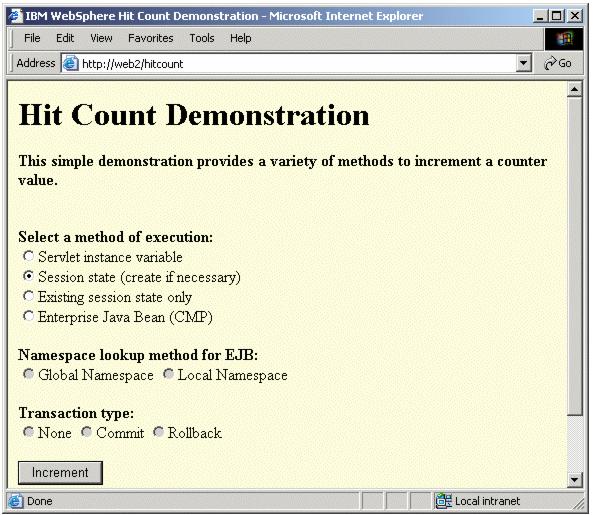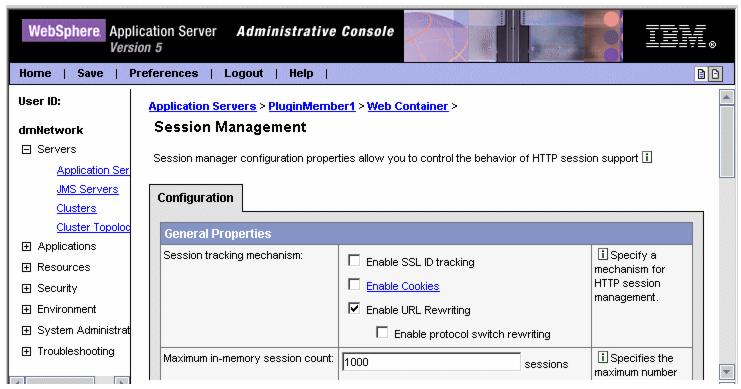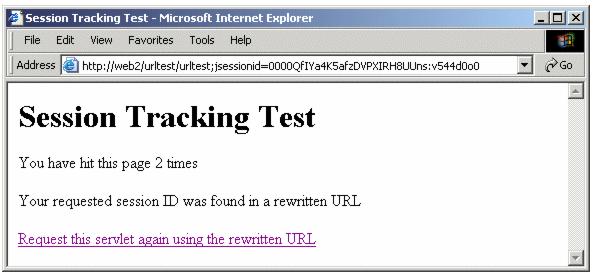Testing session management
As described before, there are three ways of tracking session management:
| Cookies |
| SSL ID |
| URL rewriting |
Cookies
<Log LogLevel="Trace" Name="C:\WebSphere\AppServer\logs\sesstrace.log"/>

Figure 5-17 Setting Cookies for session management.
http://<yourWebServer>/hitcount

You should see something similar to that shown in Example 5-14.
Note: If the plug-in log does not contain any trace information, the refresh interval for the plug-in may not have been reached. Wait longer or restart the Web server. |
Example 5-14 Plug-in trace when using cookies

...
ws_common: websphereWriteRequestReadResponse: Enter
ws_common: websphereHandleSessionAffinity: Checking for session affinity
ws_common: websphereHandleSessionAffinity: Checking the SSL session id
lib_htrequest: htrequestGetCookieValue: Looking for cookie: 'SSLJSESSION'
lib_htrequest: htrequestGetCookieValue: No cookie found for: 'SSLJSESSION'
ws_common: websphereHandleSessionAffinity: Checking the cookie affinity: JSESSIONID
lib_htrequest: htrequestGetCookieValue: Looking for cookie: 'JSESSIONID'
lib_htrequest: htrequestGetCookieValue: name='JSESSIONID', value='0000UHhjdwuWJIed1Ziom5Vb6hM:v544d031'
ws_common: websphereParseCloneID: Parsing clone ids from '0000UHhjdwuWJIed1Ziom5Vb6hM:v544d031'
ws_common: websphereParseCloneID: Adding clone id 'v544d031'
ws_common: websphereParseCloneID: Returning list of clone ids
ws_server_group: serverGroupFindClone: Looking for clone
ws_server_group: serverGroupGetFirstPrimaryServer: getting the first primary server
ws_server_group: serverGroupFindClone: Comparing curCloneID 'v544d031' to server clone id 'v544d031'
ws_server_group: serverGroupFindClone: Match for clone 'was1node_PluginMember1'
ws_server: serverHasReachedMaxConnections: currentConnectionsCount 0, maxConnectionsCount -1.
ws_server_group: serverGroupCheckServerStatus: Checking status of was1node_PluginMember1, ignoreWeights 1, markedDown 0, retryNow 0, wlbAllows 2 reachedMaxConnectionsLimit 0
ws_server: serverHasReachedMaxConnections: currentConnectionsCount 0, maxConnectionsCount -1.
ws_server_group: serverGroupIncrementConnectionCount: Server was1node_PluginMember1 picked, pendingConnectionCount 1 totalConnectionsCount 3.
ws_common: websphereHandleSessionAffinity: Setting server to was1node_PluginMember1
ws_server_group: assureWeightsValid: group PluginCluster
ws_server_group: serverGroupGetFirstPrimaryServer: getting the first primary server
ws_server_group: weights_need_reset: was1node_PluginMember1: 4 max, 2 cur.
ws_server_group: lockedServerGroupUseServer: Server was1node_PluginMember1 picked, weight 1.
ws_common: websphereFindTransport: Finding the transport
ws_common: websphereFindTransport: Setting the transport(case 2): app1.itso.ibm.com on port 9088
ws_common: websphereExecute: Executing the transaction with the app server
ws_common: websphereGetStream: Getting the stream to the app server
ws_transport: transportStreamDequeue: Checking for existing stream from the queue
ws_common: websphereSocketIsClosed: Checking to see if socket is still open
ws_common: websphereGetStream: Using existing stream from transport queue
...

SSL ID
We tested session affinity using SSL ID and cookies as follows:
<Log LogLevel="Trace" Name="/usr/WebSphere/AppServer/logs/sesstrace.log"/>
https://<yourWebServer>/hitcount
Make sure to connect using https from your Web server.
You should see something similar to that shown in Example 5-15.
Note: When using SSL between the client and the Web server, WAS V5.1 will try to use SSL communication between the plug-in and the Web container. To disable this, just delete the HTTPS transport lines for the server in plugin-cfg.xml. Otherwise, refer to the redbook IBM WebSphere V5.0 Security, SG24-6573 on details of how to set up HTTPS communication between the plug-in and Web container. |
Example 5-15 Plug-in trace when using SSL ID and cookies

...
ws_common: websphereWriteRequestReadResponse: Enter
ws_common: websphereHandleSessionAffinity: Checking for session affinity
ws_common: websphereHandleSessionAffinity: Checking the SSL session id
lib_htrequest: htrequestGetCookieValue: Looking for cookie: 'SSLJSESSION'
lib_htrequest: htrequestGetCookieValue: name='SSLJSESSION', value='0001SESSIONMANAGEMENTAFFINI:v544d031'
ws_common: websphereParseCloneID: Parsing clone ids from '0001SESSIONMANAGEMENTAFFINI:v544d031'
ws_common: websphereParseCloneID: Adding clone id 'v544d031'
ws_common: websphereParseCloneID: Returning list of clone ids
ws_server_group: serverGroupFindClone: Looking for clone
ws_server_group: serverGroupGetFirstPrimaryServer: getting the first primary server
ws_server_group: serverGroupFindClone: Comparing curCloneID 'v544d031' to server clone id 'v544d031'
ws_server_group: serverGroupFindClone: Match for clone 'was1node_PluginMember1'
ws_server: serverHasReachedMaxConnections: currentConnectionsCount 0, maxConnectionsCount -1.
ws_server_group: serverGroupCheckServerStatus: Checking status of was1node_PluginMember1, ignoreWeights 1, markedDown 0, retryNow 0, wlbAllows 3 reachedMaxConnectionsLimit 0
ws_server: serverHasReachedMaxConnections: currentConnectionsCount 0, maxConnectionsCount -1.
ws_server_group: serverGroupIncrementConnectionCount: Server was1node_PluginMember1 picked, pendingConnectionCount 1 totalConnectionsCount 2.
ws_common: websphereHandleSessionAffinity: Setting server to was1node_PluginMember1
ws_server_group: assureWeightsValid: group PluginCluster
ws_server_group: serverGroupGetFirstPrimaryServer: getting the first primary server
ws_server_group: weights_need_reset: was1node_PluginMember1: 4 max, 3 cur.
ws_server_group: lockedServerGroupUseServer: Server was1node_PluginMember1 picked, weight 2.
ws_common: websphereFindTransport: Finding the transport
ws_common: websphereFindTransport: Setting the transport(case 1): app1.itso.ibm.com on port 9447
ws_common: websphereExecute: Executing the transaction with the app server
ws_common: websphereGetStream: Getting the stream to the app server
ws_transport: transportStreamDequeue: Checking for existing stream from the queue
ws_common: websphereSocketIsClosed: Checking to see if socket is still open
ws_common: websphereGetStream: Using existing stream from transport queue
...

URL rewriting
There is no servlet provided with the WebSphere samples that uses URL rewriting. To perform this test, you can either use your own example or the sample given in Appendix B, Sample URL rewrite servlet.
We tested session affinity using the URL rewrite sample given in Appendix B, Sample URL rewrite servlet as follows:
<Log LogLevel="Trace" Name="C:\WebSphere\AppServer\logs\sesstrace.log"/>

Figure 5-19 Setting URL rewriting for session management.
http://<yourWebServer>/urltest/urltest

Figure 5-20 URL rewriting example
You should see something similar to that shown in Example 5-16.
Example 5-16 Plug-in trace when using URL rewriting

...
ws_common: websphereWriteRequestReadResponse: Enter
ws_common: websphereHandleSessionAffinity: Checking for session affinity
ws_common: websphereHandleSessionAffinity: Checking the SSL session id
lib_htrequest: htrequestGetCookieValue: Looking for cookie: 'SSLJSESSION'
lib_htrequest: htrequestGetCookieValue: No cookie found for: 'SSLJSESSION'
ws_common: websphereHandleSessionAffinity: Checking the cookie affinity: JSESSIONID
lib_htrequest: htrequestGetCookieValue: Looking for cookie: 'JSESSIONID'
lib_htrequest: htrequestGetCookieValue: No cookie found for: 'JSESSIONID'
ws_common: websphereHandleSessionAffinity: Checking the url rewrite affinity: jsessionid
ws_common: websphereParseSessionID: Parsing session id from '/urltest/urltest;jsessionid=0000QfIYa4K5afzDVPXIRH8UUns:v544d0o0'
ws_common: websphereParseSessionID: Parsed session id 'jsessionid=0000QfIYa4K5afzDVPXIRH8UUns:v544d0o0'
ws_common: websphereParseCloneID: Parsing clone ids from '/urltest/urltest;jsessionid=0000QfIYa4K5afzDVPXIRH8UUns:v544d0o0'
ws_common: websphereParseCloneID: Adding clone id 'v544d0o0'
ws_common: websphereParseCloneID: Returning list of clone ids
ws_server_group: serverGroupFindClone: Looking for clone
ws_server_group: serverGroupGetFirstPrimaryServer: getting the first primary server
ws_server_group: serverGroupFindClone: Comparing curCloneID 'v544d0o0' to server clone id 'v544d031'
ws_server_group: serverGroupGetNextPrimaryServer: getting the next primary server
ws_server_group: serverGroupFindClone: Comparing curCloneID 'v544d0o0' to server clone id 'v544d0o0'
ws_server_group: serverGroupFindClone: Match for clone 'was2Node_PluginMember2'
ws_server: serverHasReachedMaxConnections: currentConnectionsCount 0, maxConnectionsCount -1.
ws_server_group: serverGroupCheckServerStatus: Checking status of was2Node_PluginMember2, ignoreWeights 1, markedDown 0, retryNow 0, wlbAllows 0 reachedMaxConnectionsLimit 0
ws_server: serverHasReachedMaxConnections: currentConnectionsCount 0, maxConnectionsCount -1.
ws_server_group: serverGroupIncrementConnectionCount: Server was2Node_PluginMember2 picked, pendingConnectionCount 1 totalConnectionsCount 2.
ws_common: websphereHandleSessionAffinity: Setting server to was2Node_PluginMember2
ws_server_group: assureWeightsValid: group PluginCluster
ws_server_group: serverGroupGetFirstPrimaryServer: getting the first primary server
ws_server_group: weights_need_reset: was1node_PluginMember1: 4 max, 4 cur.
ws_server_group: lockedServerGroupUseServer: Server was2Node_PluginMember2 picked, weight -1.
ws_common: websphereFindTransport: Finding the transport
ws_common: websphereFindTransport: Setting the transport(case 2): app2.itso.ibm.com on port 9086
ws_common: websphereExecute: Executing the transaction with the app server
ws_common: websphereGetStream: Getting the stream to the app server
ws_transport: transportStreamDequeue: Checking for existing stream from the queue
ws_common: websphereSocketIsClosed: Checking to see if socket is still open
ws_common: websphereGetStream: Using existing stream from transport queue
...

WebSphere is a trademark of the IBM Corporation in the United States, other countries, or both.
IBM is a trademark of the IBM Corporation in the United States, other countries, or both.